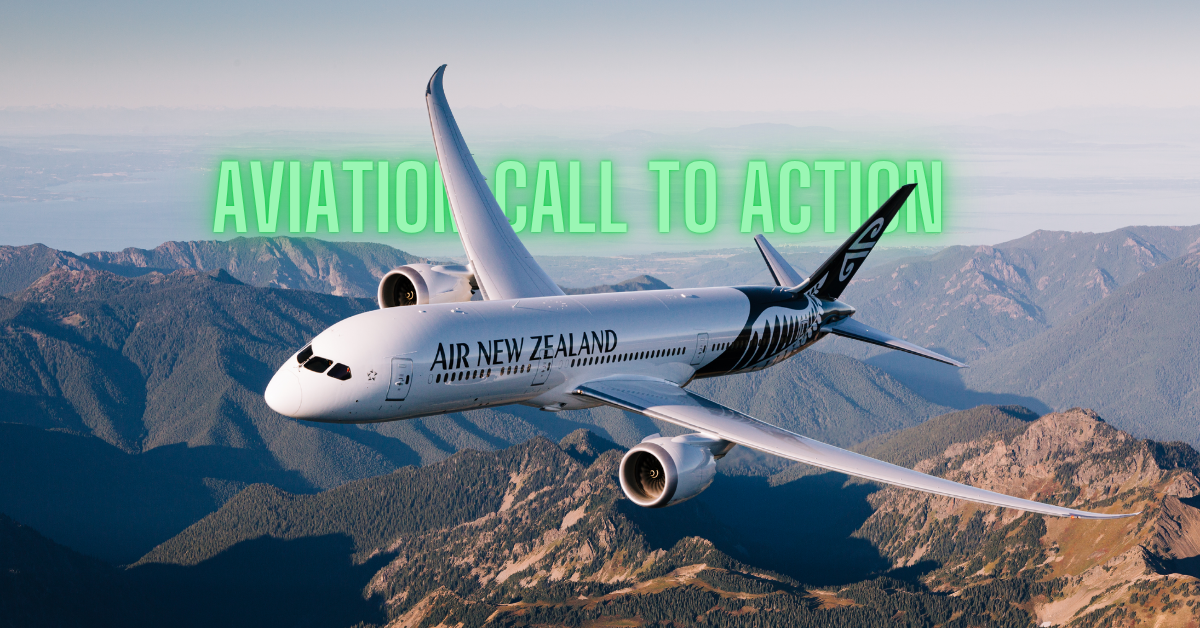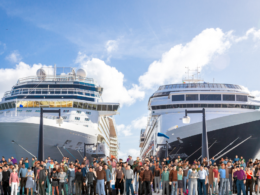Aviation is the Achilles heel of sustainable tourism. It accounts for 52% of direct global tourism emissions. For decades the aviation industry has repeatedly failed to deliver its promise of sustainable aviation. Now it appears that a new model is emerging. Finally, an industry-led voice is calling for demand management.
References
Carrington, D. (2025). Aviation industry is ‘failing dramatically’ on climate, insiders say. The Guardian 6 May 2025. https://www.theguardian.com/environment/2025/may/06/aviation-industry-failing-dramatically-on-climate-insiders-say
Carrington, D. (2025). Revealed: ‘extremely concerning’ industry influence over UN aviation body. The Guardian 14 February 2025. https://www.theguardian.com/environment/2025/feb/14/industry-influence-un-aviation-body
Milne, J. (2025). Hydrogen and biofuel setbacks force Air NZ to chart new emissions course. Newsroom. 1 May 2025. https://newsroom.co.nz/2025/05/01/hydrogen-and-biofuel-setbacks-force-air-nz-to-chart-new-emissions-course/
Peeters, P., Higham, J.E.S., Kutzner, D., Cohen, S. & Gössling, S. (2016). Are technology myths stalling aviation climate policy? Transportation Research Part D: Transport and Environment 44:30-42. 10.1016/j.trd.2016.02.004
Sun, Y.Y., Faturay, F., Lenzen, M., Gössling, S. & Higham, J.E.S. (2024). Drivers of global tourism carbon emissions. Nature Communications. DOI: https://www.nature.com/articles/s41467-024-54582-7 Dataset. https://doi.org/10.6084/m9.figshare.25059821
Transcript
The headline this week said it all: An Air NZ-Airbus initiative to build a 100-seater hydrogen plane has stalled. This and various other setbacks have plagued Air New Zealand’s once high profile and world-leading sustainability commitments. In July last year Air New Zealand scrapped its 2030 climate targets and withdrew from the Science Based Targets Initiative. This week Air New Zealand chief executive Greg Foran and chief sustainability officer Kiri Hannifin have again watered down the national carrier’s 2030 emissions reductions target.
The problems, apparently, are cost barriers facing new generation plane design and lack of green hydrogen infrastructure. In making the announcement Hannifin stood firm in her thinking that a 100-seater hydrogen plane would be very good for New Zealand but reassured readers that Air New Zealand had not spent much on the joint initiative with Airbus. “Just bits and bobs.” That might be reassuring to shareholders but won’t be of great comfort to those who are deeply concerned about aviation emissions, which includes many Air New Zealand passengers.
****
The problem is well researched and well understood. Aviation is the elephant in the room when it comes to sustainable tourism. The research led by Ya-Yen Sun (University of Queensland) and published in Nature Communications last December clearly outlines the situation. Tourism produces very high emissions and aviation continues to have the biggest emissions growth among all tourism sub-sectors. We have known for a very long time that it is the most difficult tourism-subsector to decarbonise.
The problem is that airlines and the wider aviation industry have made promises based on very challenging future technology break throughs. As a result, according to the International Energy Agency, aviation has made ‘substantially insufficient’ progress in decarbonising itself due to challenges in management, technology and fuel transition, finance, and governance. Aviation is the Achilles heel of global tourism emissions because it is both ‘big’ in terms of emissions created and ‘difficult’ to decarbonize.
In recent years Air New Zealand has backed hydrogen. The problems with hydrogen are not limited to aircraft design. Affordable and secure electricity is necessary for hydrogen to be viable. New Zealand’s supply of renewable hydro electric energy is not limitless, particularly in winter when hydro lake levels fall. This raises questions about where to direct limits renewable energy supply – industry, domestic energy use, transitioning the vehicle fleet? How much limited renewable energy supply should we commit to people’s flying luxuries, when we need to be directing renewables to domestic energy supply and electrification of private vehicles and freight. There are also supply chain issues to be addressed before large volumes of hydrogen could transported to places like airports.
****
Pushing forward with efforts to decarbonise aviation is creditworthy and should be applauded – not criticised. Investment and innovation are required to address enormous challenges like the problem of aviation emissions. However, what can be criticised is the deployment of uncertain and in some cases completely unrealistic technical solutions to counter or quell calls for decisive action and therefore to perpetuate the current demand growth model that underpins ‘business-as-usual’.
In the science community proclaiming imminent technology breakthroughs to address technical deficit is called ‘techno-fantasy’. Researchers such as Paul Peeters, himself an aircraft engineer, have long pointed out the problems with hydrogen, and battery electric flight. Ten years ago in 2016 we published a paper that confronted the problem of aviation technology myths. In the paper we noted that while emissions from aviation increase, airlines and airline organisations continue to claim that aviation will become climatically sustainable. We investigated this paradox by reviewing fuel-efficiency gains since the 1960s in comparison to aviation growth and emissions. The link between demand growth and emissions growth was obvious. As demand grows so too do emissions.
We then linked these results to aviation technology discourses over a 20 year period. We examined reporting on technologies in three broad categories. Airframe design (eg composite aircraft), engines (e.g., solar and electric) and alternative fuels (e.g., hydrogen). We found that a wide range of solutions had been presented by industry and hyped in global media, only to subsequently vanish and be replaced by different technology promises. Redundant discourses often lingered in the public domain, where they continued to be associated with industry the promise of ‘sustainable aviation’ and ‘zero-emission flight’. In the paper we discussed a number of technology discourses that constitute ‘technology myths’, and the role these ‘myths’ may play in the enduring but now long overdue promise of sustainable aviation.
We concluded that technology myths require policy-makers to interpret and take into account technical uncertainty, which may result in inaction that only delays much needed progress in climate policy for aviation. We wrote that paper in 2015. Ten years later, it precisely reflects the current discourse. The promises are made, reductions in aviation emissions remain illusive, and targets have been dropped.
****
There is really only one thing that has changed. Air New Zealand has clearly decided to shift from making promises about sustainable aviation, to being more honest with the public about the challenges it faces in this domain. The message is obviously disappointing, but the change in messaging is important. Like other airlines around the world, Air New Zealand can not continue to make bold statements about decarbonisation for fear of climate litigation action. There are now legal risks involved in climate greenwashing, which arises if companies are found to have knowingly misled the public.
Hannifan’s comments, while disappointing, were also refreshing in their (long overdue) honesty. She commented that: “When I started at Air NZ, there were quite a few little manufacturers looking at next generation aircraft, whether it was electric or hybrid or hydrogen. That’s dropped away. Some of them don’t exist anymore. They’ve gone bankrupt, they’ve gone under, they’ve changed direction.” She also commented that “…progress around next generation aircraft, or different engine type aircrafts, is not progressing at the speed it was a few years ago.”
Other problems continue. Sustainable aviation fuel (SAF) is now a central pillar of aviation decarbonisation strategies, and is considered the only scalable pathway to net zero for long-haul flight. But it is inherently problematic in terms of opportunity costs, environmental impacts and supply.
Supply of sustainable aviation fuels is limited. Earlier projections of SAF production and cost have proved to be optimistic. While production of SAF doubled last year it still represents only 0.3% of global jet fuel production. And because demand for SAFs from airlines is high, so too is the cost – several times more expensive than conventional aviation fuel. The fact that governments continue to give subsidies for oil and gas exploration and production is also extremely unhelpful in advancing the transition away from fossil fuel dependence.
So, all in all, no good news for decarbonising aviation – as we have actually long known. The last three decades is littered with cases of techno fantasy and the perpetuation of technology myths, and a cast iron conviction in aviation circles that a sustainable aviation future exists. Until recently Air New Zealand was committed to Science Based Targets and the promise that it would reduce absolute carbon emissions by 16.3 percent by 2030. The announcement this week is a commitment to “…its own more fluid target” which centres on reducing “well-to- wake” jet fuel net emissions by 20-25%. So what exactly does that meant?
“Well to wake” emissions are the total life course emissions from jet fuel, including fuel production, distribution and combustion in flight. This essentially means that Air New Zealand can claim reductions on production and distribution emissions, without necessarily achieving any actual flight emissions reductions. This is a very different and greatly watered down shift away from reducing absolute air travel emissions. Air New Zealand is still targeting net zero by 2050 but with a track record of failed ambitions that is high risk.
This is all very disappointing but not a surprise. The science community has been questioning aviation emissions reduction claims for many years. That said, the new honesty is actually refreshing, and a critical step towards real action. The techno-fantasy phase of denial and misplaced hope has, it seems, come to an end. That is good news. Climate action can clearly no longer be based on empty promises. But if so, what’s next?
****
Well, the problem remains. Flying produces high emissions that are driving climate change. Those emissions are also highly inequitable. Demand for flying is driven by the most wealthy. We know that 1% of the world’s population is responsible for 50% of aviation emissions. Meanwhile the ICAO expects global passenger numbers to double by 2042. The aviation industry continues to claim that more efficient aircraft, sustainable fuels and the CORSIA offsetting scheme will control carbon emissions. But we know that is not possible under current technologies and current growth projections.
These plans have been described as “critically insufficient” by Climate Action Tracker. Independent experts have warned that such measures are extremely unlikely to adequately address emissions from future growth in air traffic, particularly given that scope for further efficiency gains under current aircraft design have been largely exhausted.
It is clear that ICAO is captured by the interests of the aviation industry and is unable to deliver science-based climate action to decarbonise air travel. But now a new and encouraging initiate has emerged. Damian Carrington writing in The Guardian has recently reported on the Aviation Call to Action. This call has come from a recently formed group of aviation professionals who argue that their industry is “failing dramatically” in its efforts to tackle its role in the climate crisis. The Aviation Call to Action is demanding the need for a fundamental transition of the industry, including controlling flight numbers.
This is an intriguing development because the Aviation Call To Action is actually industry-led. One of the founders of the group is Karel Bockstael, who until 2022 was vice-president of sustainability at KLM Royal Dutch Airlines. She, according to The Guardian, has said that in her view “…ICAO have been failing dramatically” on its responsibility. So the Aviation Call to Action has “…identified the need to break the silence and encourage our industry leaders to become part of this transition.” This transition requires the industry to acknowledge the need to manage global demand for flights in a fair way that offers equitable access to flying in developing countries and addressing heavy frequent flyers in rich nations.
The problem has now become more clear and simple. The model has to change if we are to bring aviation emission under control. It is necessary to move away from unrestrained growth and promises of a low carbon aviation future. Airlines can not control their emissions under this approach regardless of what they promise – that is clear. It is now necessary that airlines cap their emissions in alignment with climate commitments (or risk having them capped for them).
Emissions reductions, then, are achieved by reducing flying distances or flying frequency. Hard absolute annual emissions reductions can be achieved based on demand management. Increases in future efficiencies can then be used to maintain sustainable levels of demand (with reduced emissions). Until the promise of climatically-sustainable aviation finally arrives demand management is all we have got to stabilise and reduce aviation emissions.
****
So does Air New Zealand accept that reducing how much we fly is necessary to meet emissions reduction targets under current technology? When asked Kiri Hannifin said “It’s a good question, and I wrestle with this a lot. We are such an isolated nation, and we’re a difficult country to get around locally as well. Flying is often necessary, especially to leave the country”. That doesn’t answer the question. So we can safely assume that for now the answer is ‘no’. To be honest it is more than we can reasonably expect for the Air New Zealand chief sustainability officer to say yes to demand management. But it is a huge step forward to now be actually asking the demand management question out loud.








